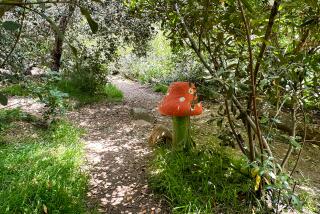Giant Reed a Threat to Life Along Bull Creek : Environment: County earmarks $200,000 to combat the <i> Arundo donax</i> infestation in Sepulveda Basin Recreation Area.
- Share via
ENCINO — Only about 100 yards from speeding traffic and just beyond the range of errant golf balls, the giant reeds rise 20 feet or more, clacking together in the hot afternoon wind.
Easily mistaken for bamboo, with leaves that form a jungle canopy over the slow-moving waters of Bull Creek, the Arundo donax provides an exotic, inviting contrast to the concrete floor of the San Fernando Valley and the nearby man-made lake.
They are lush. And they are Big Trouble.
“The pernicious, insidious nature . . . of this Arundo is just overwhelming,” said Jill Swift of the Coalition to Save Sepulveda Basin. “I don’t know of anything you can use Arundo for.”
And so Swift and other local conservationists were thrilled by news this week that the Los Angeles County Board of Supervisors is providing a $200,000 grant to combat the reed infestation along the creek, which meanders through the Sepulveda Basin Recreation Area.
The grant, given jointly to the Los Angeles city government and the Los Angeles office of the National Audubon Society, comes from a fund created by Proposition A, the 1992 property assessment measure passed to promote parkland improvements and acquisitions. Most of the money will go to pay California Conservation Corps crews to uproot the plant.
Conservationists hope the project will help save one of the last natural-state tributaries of the Los Angeles River.
But what’s so awful about Arundo donax anyway?
“It keeps trees from growing, it keeps shrubs from growing,” explains Melanie Ingalls of the Los Angeles office of the Audubon Society. “This is nasty stuff.”
Imported from Spain over 100 years ago, the giant reed was first planted to control erosion, mainly along waterways. Conservationists soon discovered, however, that the plant was nearly impossible to control.
It spread rapidly, it seeds borne both by water and air, and eliminated nearly everything in its path. It displaced native plants and forced out animals. It choked healthy streams.
With seeds that spread easily, the plant can move through a river system quickly. Bull Creek is not the only Southland waterway being invaded by the reed. The Nature Conservancy is fighting a thick infestation along the Santa Ana River in Orange County, and nature lovers say the problem is growing along numerous other streams.
It is unclear how and when Arundo was introduced along Bull Creek, although it probably occurred several decades ago. The most likely scenario has seeds being transported downstream from infestations near the creek’s headwaters in the Simi Hills.
What is clear is the damage the reed has inflicted on the creek between Victory Boulevard and the Los Angeles River.
“We very rarely see anything good anymore,” said Sandy Wohlgemuth, conservation chairman for the local Audubon Society, referring to the many species of plants and animals that formerly called the stream home. “And the reason is the proliferation of non-native weeds.”
*
As the breeze rattled through the thickets on a recent afternoon, a great blue heron burst from the slow-moving waters of the narrow stream. Later, a pair of egrets wandered a nearby paths. But these were the only signs of life over a two-hour stretch.
Before the reed came, brightly colored wood ducks with their sculpted crowns regularly paddled the creek, Wohlgemuth said. Brown bitterns and various owls patrolled the banks in search of food and nesting materials. No more.
“It’s utterly useless as far as bird habitat is concerned,” he said of the reed. “We never see any birds in the Arundo .”
The giant stalks also crowd out many native plants, sucking up as much as five times the water of the typical stream-side flora and growing as much as six inches in a day. Many of the sycamore trees of old are gone, as are most willows and elderberry bushes.
The reeds have already begun to clog the stream, threatening the minnows and other small aquatic creatures that require flowing water to flourish. And with the confluence with the Los Angeles River just a few hundred yards downstream, experts say waterborne Arundo seeds could easily take root along the big waterway’s banks.
Removing the reeds--as well as the less troublesome but also non-native castor bean and tree tobacco--is an ambitious project. It will likely last about four months after getting under way some time this fall.
To keep the hardy reeds from returning, crews will have to hack through the stalks just inches above the ground. Then, in the minutes before the reeds can excrete a protective gel, they must coat the exposed trunks with a herbicide.
Bull Creek has been severely damaged, those involved in the project say, but not irreparably. Once the Arundo is removed, the stream should flourish again.
Said Swift: “You’re going to start seeing birds in there you didn’t know existed.”
Arundo Attack A non-native, bamboo-like plant called Arundo donax is infesting Bull Creek in the Sepulveda Dam Recreation Area. Money from a Proposition A fund will be used to hire crews to remove the aggressively growing plant. *
Arundo Donax Description: Commonly referred to as bamboo or cane. Can reach a height of 20 feet or more, with leaves two feet long. Habitat: Needs rich, moist soil such as wetland habitat. A water guzzler, its roots tap into ground water, denying moisture to nearby plants. Origin: Europe Residential use: Planted as windbreak or to control erosion.
More to Read
Sign up for Essential California
The most important California stories and recommendations in your inbox every morning.
You may occasionally receive promotional content from the Los Angeles Times.













